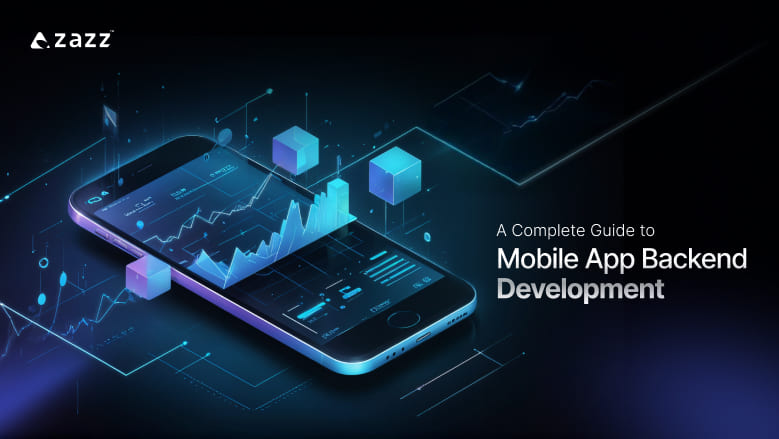
Creating a successful mobile app involves much more than just a sleek design and user-friendly interface. At the heart of every high-performing application is a strong backend that handles everything from data management to processing and security. This is what ensures that your app not only looks good but also works smoothly and efficiently behind the scenes.
In this guide, we’ll dive deep into the essentials of mobile app backend development. Whether you’re building your first app or looking to enhance an existing one, understanding how to develop a robust backend is crucial. We’ll walk you through the key components that contribute to a solid backend and discuss how these elements can make or break your app’s performance. So, let’s begin!
What is Mobile App Backend Development?
Backend mobile app development is all about setting up the parts of your app that you don’t see but that keep everything running smoothly. This includes the server and the processes that happen on the server- like storing data, securing user information, and ensuring everything the user does on the app runs efficiently.
hat is Mobile App Backend Development?
Developing a good backend means your app can handle data effectively, process user requests quickly, and scale up as more people use it without running into problems. This is crucial for the app’s performance and the satisfaction of its users.
Related reading: How can react native reduce mobile app development costs?
Frontend Vs. Backend Development
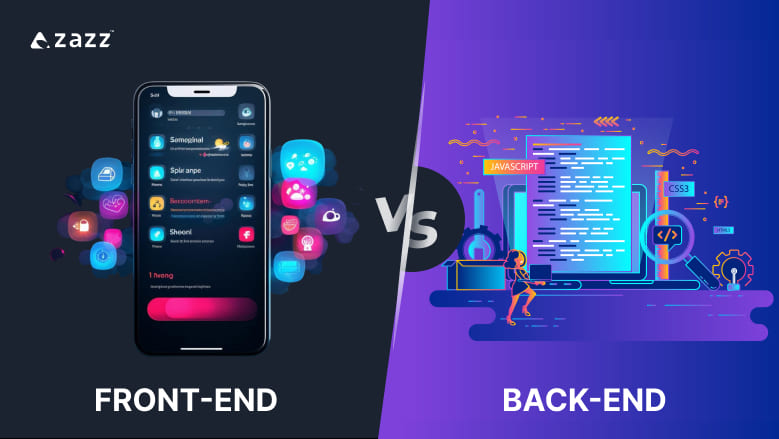
When creating a mobile app, frontend development is the designing part of the app that you can see and interact with. It involves everything from the buttons you tap on to the text you read and the images you scroll through.
Frontend developers focus on making sure the app is visually appealing, easy to navigate, and responsive, meaning, it works well on various devices and screen sizes. They work with design elements and user experience to make sure that using the app feels intuitive and engaging.
Now, moving to backend mobile app development, this is the powerhouse behind the app where all the heavy lifting takes place behind the screen.. The backend manages the server, databases, and APIs that handle tasks like storing user data, processing login requests, and ensuring that your interactions on the app are secure.
For instance, when you post a photo on a social media app, the frontend lets you pick the photo and hit ‘post’, but the backend for the mobile app takes care of uploading your photo, storing it securely, and displaying it to your friends.
In essence, while frontend development ensures the app looks good and is enjoyable to use, backend development makes sure it functions smoothly.
Types of Mobile App Backend Development
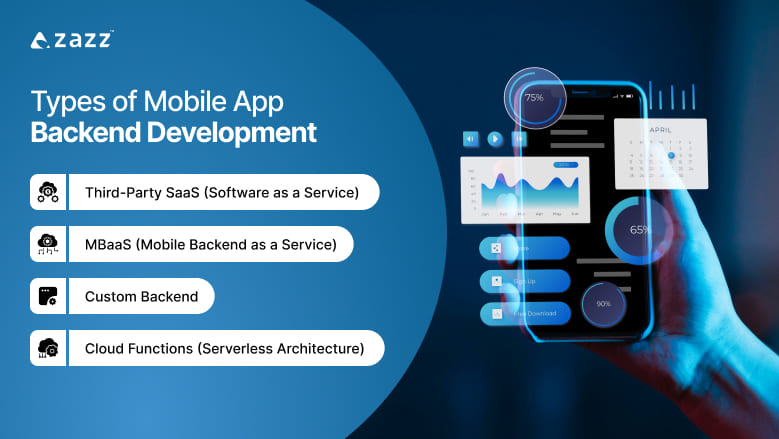
Mobile app backends can be categorized based on their architecture and the specific needs they fulfill. Understanding the different types of mobile app backend services can help developers choose the most suitable option for their project. Here are the main types of backend for mobile apps:
Third-Party SaaS (Software as a Service)
Third-party SaaS development platforms like Firebase and AWS Amplify give developers pre-built features that can be easily added to mobile apps. This saves time and lets developers focus on improving the app’s functions. These platforms provide essential services such as databases, file storage, and serverless functions, helping developers to build scalable and feature-rich backends quickly. Additionally, these platforms are also considered MBaaS (Mobile Backend as a Service) because they offer backend services specifically for mobile apps.
MBaaS (Mobile Backend as a Service)
MBaaS, or Mobile Backend as a Service, is a cloud computing model that equips developers with an already established backend infrastructure. This model supplies a suite of backend services including data synchronization, file storage, and serverless computing. MBaaS platforms come with pre-built components that expedite development, yet they still allow for customization to fit specific project needs. Typically, this service runs on a subscription model where users pay a monthly fee. It’s worth noting that while MBaaS is a distinct service aimed at mobile app development, it shares similarities with Third-Party SaaS products, often blurring the lines between the two.
Custom Backend
Custom backend in app development involves building and managing a backend specifically tailored to the app’s requirements. This method involves setting up servers, databases, and APIs development from scratch. It provides complete control and flexibility over backend functionalities, data management, and security. A custom backend can involve higher initial costs but may lead to lower long-term costs due to better optimization and efficiency could add depth
Cloud Functions (Serverless Architecture)
Serverless architecture allows developers to write backend functions hosted on managed cloud services that execute in response to specific events, such as HTTP requests. Serverless architecture abstracts the server management but does not eliminate the need for effective architecture design, as poorly designed serverless functions can lead to inefficiencies. Services like AWS Lambda and Azure Functions enable code to run without the need to manage servers, making this approach scalable and cost-effective. You only pay for the compute time you use, which helps keep costs down while maintaining high scalability.
Related reading: Unlocking Mobile App Success through Seamless UI/UX
The Main Components of Backend App Development
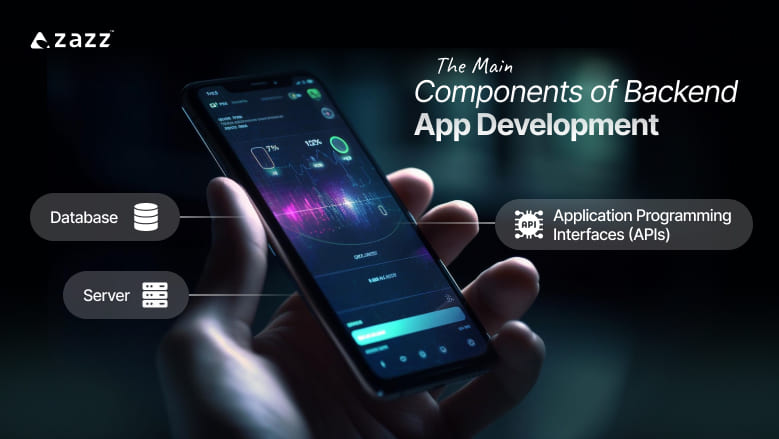
Below are the essential elements that contribute to the effectiveness of a mobile application backend architecture:
Application Programming Interfaces (APIs)
APIs are crucial for linking your mobile app with the backend server and ensuring smooth data flow. They define how your app communicates with the backend, detailing everything from how requests are made to how data is formatted and secured. This setup helps maintain efficient and uninterrupted data exchanges between the app and its server.
Database
The database is a fundamental element of backend development, storing all the critical data your app needs, such as user profiles, content, and other key information. It handles the storage, retrieval, and management of data, ensuring that your app can quickly access and process the information it requires. Depending on your app’s needs, you might choose between a relational database or a NoSQL database.
Server
The server is the powerhouse of your app’s backend. It processes and responds to requests from the app’s users, managing data flow back and forth. Essentially, it acts as the central hub for your app’s data management, ensuring that user requests are handled efficiently and securely.
How Does Mobile App Backend Development Work?
If you consider the front end of a mobile app as the visible interface where you directly interact, then the backend would be the engine that powers all the operations behind the scenes. Essentially, the backend is where all the data processing occurs, and it communicates with the front end to respond to user requests.
Without a backend, the front end would be like a car without an engine—nice to look at but not functional. And without the front end, users would have no way to interact with the app’s features.
So, how do the frontend and backend communicate and understand what the user wants? They do this through APIs (Application Programming Interfaces). APIs are like messengers that relay requests and information between the front end and the backend.
Here’s a simple example to illustrate this:
Imagine you’re shopping online for a dress. You find one you like, add it to your cart, and hit the ‘Buy Now’ button to check out. This action triggers the front end of your shopping app to send a request to the backend. The backend then needs to connect with an external payment gateway to process your payment.
It does this using an API that sends your payment details securely to the payment service and then retrieves the payment page for you. You will then be able to enter your payment information directly into the banking page that appears, complete your purchase, and successfully buy the dress.
In this process, the API acts as the bridge that allows the front end and backend of the app to work together seamlessly. It ensures that the app functions smoothly and that you, as the user, have a hassle-free experience making an online purchase. The backend’s role is crucial because it processes all the data and guarantees that everything you do on the app results in the correct action being taken. Businesses that rely on these seamless integrations can benefit from API development and integration services to ensure the smooth operation of their systems and user experience.
Related reading: Is React Native Really The future of Mobile App Development
Mobile Application Functions That Are Provided With Backend Development
Mobile app backend services are crucial for supporting several important functions that help an app run without hindrance. Here’s a breakdown of the key functions provided by backend development:
Data Management and Storage
The backend is where all the app’s data is kept—like user information and app settings. It handles saving, retrieving, and updating this data to ensure everything is current and secure.
User Authentication and Authorization
This part of the backend checks who is using the app and what they have permission to see or do. It helps keep the app secure by making sure each user is who they say they are.
API Integration and Management
Backend systems provide and manage APIs that facilitate communication between the mobile app and other systems or third-party services. This integration allows apps to offer features beyond their primary functions, such as payments, maps, or weather updates.
Push Notifications
Backend development allows for the implementation of push notifications, which are messages sent from the server directly to the user’s mobile device. This feature is crucial for engaging users and keeping them updated with new content or alerts.
Performance Optimization
Backends are designed to efficiently manage resources, which helps balance load and improve app responsiveness. This includes scaling resources up or down based on demand to handle high user loads during peak times.
Security Measures
When you build a backend for a mobile app, it includes security protocols to protect data and transactions from unauthorized access, breaches, and other cyber threats. This typically involves encryption, secure data transmission, and regular security audits to ensure the highest level of security.
Analytics and Reporting
Backend systems collect and analyze data on user behavior and app performance. This data is crucial for understanding usage patterns, improving app features, and making informed business decisions based on comprehensive reports.
What Types of Apps Require Backend Development?
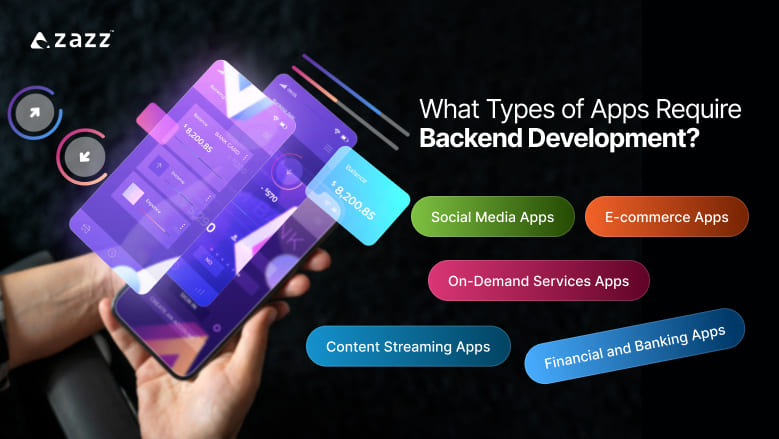
Backend development is essential for many types of mobile apps that require data management, real-time interactions, and complex functionalities. Here are some types of apps that typically require strong backend development:
Social Media Apps
These apps require robust backend systems to manage vast amounts of user data, interactions, and real-time updates. They handle user authentication, content posting, messaging, and notifications.
Examples: Facebook, Instagram, and Twitter
E-commerce Apps
E-commerce apps rely on backend services to manage product inventories, user profiles, orders, payments, and even customer service interactions. They often include features like search functionalities, user reviews, and personalized recommendations.
Examples: Amazon and eBay
On-Demand Services Apps
These apps need backends to dynamically match user requests with service providers, handle billing, manage user and provider ratings, and integrate with maps and payment systems for real-time services.
Examples: Uber and Airbnb
Content Streaming Apps
Streaming apps require backends capable of managing large content libraries, supporting media streaming without lags, handling user subscriptions, and protecting copyright material.
Examples: Netflix, Spotify, and Amazon Prime Video
Financial and Banking Apps
These apps need highly secure and reliable backends for processing transactions, encrypting sensitive data, managing user accounts, and complying with financial regulations.
Examples: Mobile banking apps and trading platforms
Related reading: How to develop a Recognition Mobile App Using Latest Technologies?
Best Backend Frameworks for Mobile App Development
Here’s a list of some of the best backend frameworks that developers commonly use to build a backend for a mobile app:
Node.js
Known for its speed and scalability, Node.js is a JavaScript runtime built on Chrome’s V8 JavaScript engine. It’s particularly good for building real-time applications and streaming apps due to its non-blocking, event-driven architecture.
Django
Built on Python, Django is a high-level framework that encourages rapid development and clean, pragmatic design. It comes with a lot of built-in features, such as authentication and messaging, which makes it highly efficient for developers looking to get their apps up and running quickly. Django is particularly well-suited for apps with complex data requirements, like CMSs or financial platforms.
Laravel
Laravel is a PHP framework for mobile and web app development known for its elegant syntax and robust features. It provides a rich set of functionalities which includes everything from routing, sessions, and authentication to caching and ORM (Object Relational Mapping). Laravel comes packed with tools for easy database migration, a schema builder, a powerful queue library, and simple authentication logic.
FlaskHow Does Mobile App Backend Development Work?
Another Python-based framework, Flask is considered more lightweight and modular compared to Django. It gives developers more flexibility and control but requires them to build more features from scratch or via third-party libraries. Flask is ideal for smaller apps or when you need a highly customizable backend.
Related reading: How AI is Transforming Mobile App Development
Conclusion
As we’ve explored in this guide, the backbone of any high-performing mobile app is its robust backend. From handling complex data transactions to ensuring smooth and secure app functionality, the backend is where the magic happens. Zazz stands at the forefront of backend development, offering tailored solutions that empower your mobile apps to operate seamlessly and efficiently.
At Zazz, we understand that each app’s needs are unique, and we specialize in crafting bespoke backend solutions that cater to these specific requirements. Whether you’re looking to integrate third-party services, manage large data sets, or ensure flawless real-time operations, our expert team is equipped to deliver top-tier development services that will set your app apart from the competition. So, contact us today!
Frequently Asked Questions
Mobile app backend development involves setting up and managing the server-side technology that supports the app’s functionality, such as data storage, user management, and server logic.
Zazz provides comprehensive backend development services, including custom server setups, database management, API integration, and much more. This ensures your app is robust, scalable, and secure.
A good mobile app backend is scalable, secure, efficiently handles data, and supports the app’s user interface with minimal latency.
A strong backend improves app performance, enhances security, provides a better user experience, and supports the app’s scalability as your user base grows.
Android app backend development involves creating the server-side infrastructure that supports an app’s operations, such as data management and user authentication. This development ensures that the app can handle complex functions securely and efficiently.
Recent Articles
Table of Content 1. What is IT Staff Augmentation? 2....
Table of Content 1. What is Staff Augmentation for App...
Table of Content 1. What is IT Staff Augmentation? 2....












